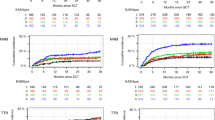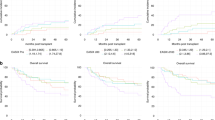Abstract
The roles of angiogenesis and angiogenic factors after allogenic hematopoietic SCT (HSCT) and during acute GVHD (aGVHD) are not known. Studies on pediatric patients are extremely scarce. Levels of angiopoietin-2 (Ang2) and vascular endothelial growth factor (VEGF) were analyzed from blood samples of 67 consecutive patients. The levels were correlated with aGVHD grades, routine laboratory parameters and outcome. Pre-transplant Ang2 values correlated with the occurrence of intestinal aGVHD (P=0.009), whereas post-transplant measurements correlated with the severity of skin and liver aGVHD (P=0.03, P=0.04, respectively). Pre-transplant levels of VEGF were associated with the occurrence of skin aGVHD (P=0.04), whereas post-transplant levels correlated to the severity of intestinal aGVHD (P=0.04). High Ang2 levels were associated with shorter EFS (P=0.039) and increased non-relapse mortality (NRM) (P=0.009). In conclusion, higher Ang2 levels predict higher NRM and, with coexisting high VEGF, also shorter EFS after pediatric HSCT. Our results suggest that both pre- and post-transplant levels of Ang2 and VEGF seem to correlate to the clinical state of the patient. However, the pathophysiology of this connection needs further studies.
This is a preview of subscription content, access via your institution
Access options
Subscribe to this journal
Receive 12 print issues and online access
$259.00 per year
only $21.58 per issue
Buy this article
- Purchase on Springer Link
- Instant access to full article PDF
Prices may be subject to local taxes which are calculated during checkout





Similar content being viewed by others
References
Carmeliet P, Jain RK . Angiogenesis in cancer and other diseases. Nature 2000; 407: 249–257.
Li WW, Hutnik M, Gehr G . Antiangiogenesis in haematological malignancies. Br J Haematol 2008; 143: 622–631.
Mirshahi P, Rafii A, Vincent L, Berthaut A, Varin R, Kalantar G et al. Vasculogenic mimicry of acute leukemic bone marrow stromal cells. Leukemia 2009; 23: 1039–1048.
Podar K, Anderson KC . The pathophysiologic role of VEGF in hematologic malignancies: therapeutic implications. Blood 2005; 105: 1383–1395.
Hu B, Cheng SY . Angiopoietin-2: development of inhibitors for cancer therapy. Curr Oncol Rep 2009; 11: 111–116.
Chen L, Hamrah P, Cursiefen C, Zhang Q, Pytowski B, Streilein JW et al. Vascular endothelial growth factor receptor-3 mediates induction of corneal alloimmunity. Nat Med 2004; 10: 813–815.
Lunn RA, Sumar N, Bansal AS, Treleaven J . Cytokine profiles in stem cell transplantation: possible use as a predictor of graft-versus-host disease. Hematol 2005; 10: 107–114.
Min CK, Kim SY, Lee MJ, Eom KS, Kim YJ, Kim HJ et al. Vascular endothelial growth factor (VEGF) is associated with reduced severity of acute graft-versus-host disease and nonrelapse mortality after allogeneic stem cell transplantation. Bone Marrow Transplant 2006; 38: 149–156.
Penack O, Socie G, van den Brink MR . The importance of neovascularization and its inhibition for allogeneic hematopoietic stem cell transplantation. Blood 2011; 117: 4181–4189.
Kivivuori SM, Siitonen S, Porkka K, Vettenranta K, Alitalo R, Saarinen-Pihkala U . Expression of vascular endothelial growth factor receptor 3 and Tie1 tyrosine kinase receptor on acute leukemia cells. Pediatr Blood Cancer 2007; 48: 387–392.
Hu SW, Cotliar J . Acute graft-versus-host disease following hematopoietic stem-cell transplantation. Dermat Ther 2011; 24: 411–423.
Kaplan E, Meier P . Nonparametric estimation from incomplete observations. J Am Stat Assoc 1958; 53: 457–481.
Peto R, Pike MC, Armitage P, Breslow NE, Cox DR, Howard SV et al. Design and analysis of randomized clinical trials requiring prolonged observation of each patient. II. analysis and examples. Br J Cancer 1977; 35: 1–39.
Nachbaur D, Schumacher P, Auberger J, Clausen J, Kircher B . Vascular endothelial growth factor and activin-a serum levels following allogeneic hematopoietic stem cell transplantation. Biol Blood Marrow Transplant 2007; 13: 942–947.
Kim DH, Lee NY, Lee MH, Sohn SK . Vascular endothelial growth factor gene polymorphisms may predict the risk of acute graft-versus-host disease following allogeneic transplantation: preventive effect of vascular endothelial growth factor gene on acute graft-versus-host disease. Biol Blood Marrow Transplant 2008; 14: 1408–1416.
Banks RE, Forbes MA, Kinsey SE, Stanley A, Ingham E, Walters C et al. Release of the angiogenic cytokine vascular endothelial growth factor (VEGF) from platelets: significance for VEGF measurements and cancer biology. Br J Cancer 1998; 77: 956–964.
Hou HA, Chou WC, Lin LI, Tang JL, Tseng MH, Huang CF et al. Expression of angiopoietins and vascular endothelial growth factors and their clinical significance in acute myeloid leukemia. Leuk Res 2008; 32: 904–912.
Kumpers P, Koenecke C, Hecker H, Hellpap J, Horn R, Verhagen W et al. Angiopoietin-2 predicts disease-free survival after allogeneic stem cell transplantation in patients with high-risk myeloid malignancies. Blood 2008; 112: 2139–2148.
Nomura S, Ishii K, Inami N, Kimura Y, Uoshima N, Ishida H et al. Evaluation of angiopoietins and cell-derived microparticles after stem cell transplantation. Biol Blood Marrow Transplant 2008; 14: 766–774.
Luft T, Dietrich S, Falk C, Conzelmann M, Hess M, Benner A et al. Steroid-refractory GVHD: T-cell attack within a vulnerable endothelial system. Blood 2011; 118: 1685–1692.
Pavlakovic H, Von Schutz V, Rossler J, Koscielniak E, Havers W, Schweigerer L . Quantification of angiogenesis stimulators in children with solid malignancies. Int J Cancer 2001; 92: 756–760.
Bono P, Krause A, von Mehren M, Heinrich MC, Blanke CD, Dimitrijevic S et al. Serum KIT and KIT ligand levels in patients with gastrointestinal stromal tumors treated with imatinib. Blood 2004; 103: 2929–2935.
Author information
Authors and Affiliations
Corresponding author
Ethics declarations
Competing interests
The authors declare no conflict of interest.
Additional information
Supplementary Information accompanies the paper on Bone Marrow Transplantation website
Supplementary information
Rights and permissions
About this article
Cite this article
Porkholm, M., Bono, P., Saarinen-Pihkala, U. et al. Higher angiopoietin-2 and VEGF levels predict shorter EFS and increased non-relapse mortality after pediatric hematopoietic SCT. Bone Marrow Transplant 48, 50–55 (2013). https://doi.org/10.1038/bmt.2012.101
Received:
Revised:
Accepted:
Published:
Issue Date:
DOI: https://doi.org/10.1038/bmt.2012.101
Keywords
This article is cited by
-
Early bilirubinemia after allogeneic stem cell transplantation—an endothelial complication
Bone Marrow Transplantation (2021)
-
Biomarkers in Graft-Versus-Host Disease: from Prediction and Diagnosis to Insights into Complex Graft/Host Interactions
Current Hematologic Malignancy Reports (2018)
-
VEGF, ANGPT1, ANGPT2, and MMP-9 expression in the autologous hematopoietic stem cell transplantation and its impact on the time to engraftment
Annals of Hematology (2017)
-
The pretransplant systemic metabolic profile reflects a risk of acute graft versus host disease after allogeneic stem cell transplantation
Metabolomics (2016)
-
Circulating markers of endothelial and alveolar epithelial dysfunction are associated with mortality in pediatric acute respiratory distress syndrome
Intensive Care Medicine (2016)



